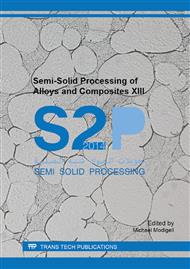p.397
p.405
p.412
p.418
p.426
p.431
p.436
p.442
p.450
Using Semi-Solid Extrusion for the Production of Aluminum-Nanocomposite Master Alloys
Abstract:
The production of nanoreinforced aluminum alloys in volume and quality suitable for subsequent shape casting has been problematic. Large specific surface area and high interfacial energy of the particles combined with high surface tension of the aluminum melt makes it difficult to add appreciable numbers of particles to the melt, even when later de-agglomerated by techniques such as ultrasonic cavitation. Previous work by the authors used semi-solid squeeze casting to produce master alloys for dilution into the casting alloy. While the technique was shown to be effective, the master alloy proved difficult to remelt and was expensive to produce. The objective of this new work was to use an extrusion process that could be more readily scaled to produce nanoreinforced aluminum master alloys. This paper describes the process developed for incorporation of nanoparticles using semi-solid extrusion and the results of alloys produced using that process.
Info:
Periodical:
Pages:
426-430
Citation:
Online since:
September 2014
Authors:
Keywords:
Price:
Сopyright:
© 2015 Trans Tech Publications Ltd. All Rights Reserved
Share:
Citation:


